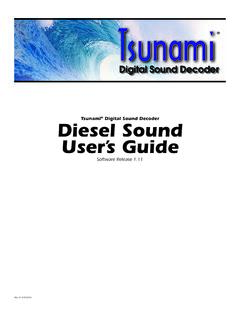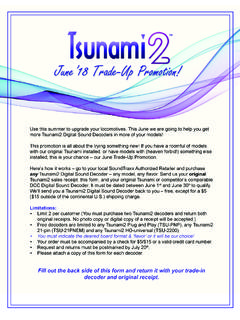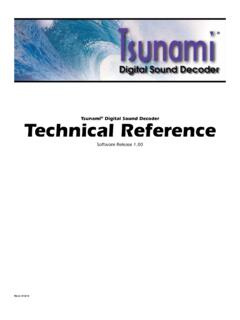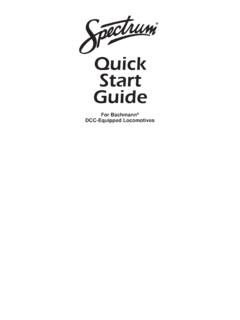Transcription of Tsunami2 Digital Sound Decoder Diesel User’s Guide
1 Rev. E 03/09/2020 Tsunami2 Digital Sound Decoder Diesel user s Guide Software Release ** ** Pervious software versions included Notice The information in this document is subject to change without notice. SoundTraxx (Throttle Up! Corp.) shall not be liable for technical or editorial errors or omissions contained herein, nor for incidental or consequential damage resulting from the furnishing, performance or use of this material. This document contains information protected by copyright. No part of this document may be photocopied or reproduced in any form without the prior written consent of Throttle Up! Corp. Product names mentioned herein may be trademarks and/or registered trademarks of their respective companies. SoundTraxx, Econami, tsunami , Tsunami2 , SoundTraxx DCC, Dynamic Digital Exhaust, Auto-Exhaust, Hyperlight, Hyperdrive2, SoundCar, CurrentKeeper and Intelligent Consisting are trademarks of Throttle Up!
2 All Aboard! .. 4 Overview .. 4 Using Tsunami2 .. 5 CV Programming Tutorial .. 11 Introduction to Programming .. 14 Basic Programming .. 18 Configuring the Address .. 18 Configuring the Decoder .. 19 Configuring Throttle and Braking .. 21 Configuring Lighting Outputs .. 28 Configuring Sound Effects .. 33 Configuring Automatic Sounds .. 41 Advanced Programming .. 46 Configuring Audio Control .. 46 Configuring Dynamic Digital Exhaust .. 52 Configuring Function Mapping .. 55 Configuring Hyperdrive2 .. 61 Configuring Advanced Consist Operation .. 65 Miscellaneous Features .. 69 Configuring Analog Mode Operation .. 69 Operating With a CurrentKeeper .. 72 Gas Turbine Electric (GTEL) Features & Operation .. 73 GenSet Specific Features and Operation .. 77 Troubleshooting .. 80 Sorting Out Decoder Difficulties .. 80 Appendix A: Decimal-Hex-Binary Conversions .. 83 Appendix B: Tsunami2 Diesel CV Reference.
3 84 Appendix C: License Agreement .. 85 Appendix D: Service and Warranty Policy .. 86 Appendix E: Declaration of Conformity .. 87 All Aboard! Tsunami2 Diesel user s Guide 4 All Aboard! Overview Congratulations on purchasing your SoundTraxx Tsunami2 Digital Sound Decoder (DSD) for Diesel locomotives! Tsunami2 is the newest wave of SoundTraxx innovation and builds upon the previous generation of tsunami to offer the highest quality Sound for model railroading. This user s Guide shows you how to operate Tsunami2 and customize each Decoder setting to fit your preferences, while providing some helpful troubleshooting tips along the way. We suggest referring to the following resources listed below as you read this user s Guide . Tsunami2 Installation Guide Provides instructions and strategies for successful Sound installations. Tsunami2 Diesel Technical Reference Offers a list of all included CVs and details making adjustments to settings.
4 Tsunami2 Sound Selection References Lists each included Sound effect for configuring a prototypical operating experience. Decoder Selector Assists in selecting the correct Decoder and speaker for many models in all scales. Videos Page Provides instructional videos and product demonstrations. Diesel Sound Samples Offers Sound file previews of prime movers and airhorn selections. Reference Documents Includes helpful information such a glossary terms and specific installation information. Technical Notes Provides notes about wiring practices and DCC compliance tests. CurrentKeeper Reference Includes supplemental information about operating and programming with this device. Factory Installed Decoders Visit this page for specific CV values and feature information for factory installed models. These resources can be viewed and downloaded from our website at All Aboard! Tsunami2 Diesel user s Guide 5 Using Tsunami2 The Tsunami2 Digital Sound Decoder is designed to enhance your model railroading experience by giving you a wide variety of innovative features and incredibly realistic Sound for your models.
5 Some of the features discussed in this user s Guide include Dynamic Digital Exhaust for Diesel locomotives, Hyperdrive2 advanced motor control, Flex-Map function mapping technology, prototypical dynamic braking, two volume mixers, HEP mode, independent and train brake functions and Fireman Ed Sound effects. Tsunami2 also provides selectable airhorns, bells, prime movers, air compressors and couplers to allow more versatility in creating your ideal model railroading experience. You can start using Tsunami2 right out of the package without making any adjustments. However, you may adjust settings at any time by making changes to Configuration Variables (CVs). Most DCC Decoder and command station manuals call this programming , though this is misleading and sounds scarier than it is. At no point are you required to learn programming! This user s Guide will walk you through operating and programming Tsunami2 to its full capacity.
6 Default Function Assignments The first time you operate your Tsunami2 Decoder , you will be able to activate features and Sound effects by simply pressing the appropriate key on your cab or command station console. These are default function assignments. The effects listed in Table A are assigned to function keys F0-F28 by default. This section describes how to activate each effect with function keys. Note: You can assign any effect to function keys labeled as Not Assigned in Table A with Flex-Map function mapping CVs. Refer to Configuring Function Mapping for more information about customizing function assignments. Note: Pressing function keys F0-F28 will toggle functions on and off and activate effects. Turn On the Lights Ensure your locomotive is in the forward direction, then turn on F0 to illuminate the headlight. Reverse the locomotive direction to turn off the headlight and turn on the backup light.
7 Pressing F0 a second time will turn off the headlight and backup light outputs. Turn on F7 to dim the headlight or backup light before passing oncoming trains, or while waiting on a siding. Press F7 again to return the headlight and backup light outputs to full brightness. * Auxiliary HEP generator and straight-to-idle are not included in software releases prior to version Table A. Default Functions Key Effect F0(f) Headlight F0(r) Backup Light F1 Bell F2 Airhorn F3 Short Airhorn F4 Dynamic Brake F5 RPM+ F6 RPM- F7 Dimmer F8 Mute F9 Grade-Crossing Signal F10 Straight-to-Eight F11 Independent/Train Brake F12 Brake Select F13 Couple/Uncouple F14 Switching Mode F15 Handbrake F16 HEP Mode or Turbine Start/Stop F17 Fuel Loading F18 General Service F19 Straight-to-Idle* F20 Steam Gen. or Auxiliary HEP Gen.* F21 Sander Valve F22 Cab Chatter F23 All Aboard/Coach Doors F24 FX3 Function Output F25 FX4 Function Output F26 FX5 Function Output F27 FX6 Function Output F28 FX7 & FX8 Function Output All Aboard!
8 Tsunami2 Diesel user s Guide 6 Ring the Bell Turn on F1 to ring the bell. Press F1 again to stop ringing the bell. The bell is generally rung before moving the locomotive, when approaching crossings, to alert people or equipment near the track, and as a warning signal when necessary. Blow the Airhorn Signaling can make your operating sessions more fun! Engineers signal to notify passengers, crew, and other trains of common locomotive movements, such as stopping, moving forward, backing up, and approaching grade crossings. Tsunami2 provides three functions for signaling. Use F2, F3, and F9 to signal prototypically while you operate, as described below. Press and release F2 to blow the long airhorn. Contrary to most function keys, the duration of the airhorn blast is determined by how long you press F2. In other words, the airhorn blast will start when you press F2, and stop when you release F2.
9 Press F3 to issue the single toot of the short airhorn. The short airhorn will be the same length every time you press F3, unlike the long airhorn. Note: Function key F2 on the NCE Power Cab command station is on/off or latching , , pressing F2 to turn on the function will start the airhorn blast, and pressing F2 again to turn off the function will stop the airhorn blast. To issue momentary airhorn blasts with the NCE cabs, press and release the Horn/Whistle button instead of using F2. To issue the long-long-short-long grade-crossing signal automatically, turn on F9 as your locomotive approaches a grade crossing. Refer to Table B to view some more common signals. Table B. Whistle Signals Long = Short = Signal Description Approaching a grade crossing: hold final blast until crossing is occupied Applying brakes Releasing brakes, proceeding forward When moving, stop; when stopped, back up Request signal from trainman Signal flagman to protect rear Warning signal: use when approaching areas with obstructed views and when approaching/passing passenger/freight trains Approaching stations, junctions, and railroad crossings at grades Operate the Diesel Prime Mover To start the Diesel engine, simply increase the throttle until the track voltage is such that the engine cranks over several times and settles into a nice idle.
10 Once the engine has reached idle, it will change RPMs automatically in response to changes in the locomotive speed. Alternatively, pressing F5 will start the engine and increase the RPMs with subsequent presses. Pressing F6 will cause the Sound of the engine shutdown. Contrary to the way your car works, a Diesel engine generates power by turning an electric generator. The generator delivers electricity to traction motors mounted on the axles, which then set the locomotive wheels in motion. The traction motors are able to produce ample rotating power at any speed without needing to shift gears. All Aboard! Tsunami2 Diesel user s Guide 7 For example, a Diesel locomotive climbing a grade at full throttle and maximum engine RPM may only be traveling about 20mph, whereas the engine RPM of your car directly corresponds to how fast you re traveling. Because of their size (an EMD 645 displaces 645 cubic inches per cylinder!)





